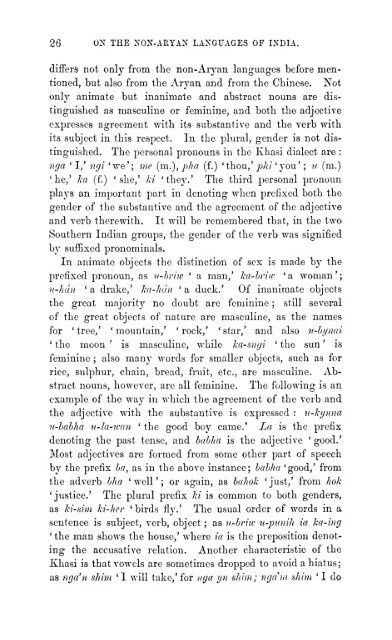Create successful ePaper yourself
Turn your PDF publications into a flip-book with our unique Google optimized e-Paper software.
26<br />
ox THE XON-ARTAX LAXGUAGES OF INDIA.<br />
differs not onlj'' from <strong>the</strong> <strong>non</strong>-<strong>Aryan</strong> <strong>languages</strong> before mentioned,<br />
but also from <strong>the</strong> <strong>Aryan</strong> and from <strong>the</strong> Chinese. Not<br />
only animate but inanimate and abstract nouns are dis-<br />
tinguished as masculine or feminine, and both <strong>the</strong> adjective<br />
expresses agreement with its substantive and <strong>the</strong> verb with<br />
its subject in this respect. In <strong>the</strong> plural, gender is not dis-<br />
tinguished. The personal pronouns in <strong>the</strong> Khasi dialect are :<br />
nga 'I,' ngi 'we'; me {m.), pha (f.) 'thou,' j';/ii 'you' ; w (m.)<br />
' he,' ka (f.) ' she,' ki ' <strong>the</strong>y.' The third personal pronoun<br />
plays an important part in denoting when prefixed both <strong>the</strong><br />
gender <strong>of</strong> <strong>the</strong> substantive and <strong>the</strong> agreement <strong>of</strong> <strong>the</strong> adjective<br />
and verb <strong>the</strong>rewith. It will be remembered that, in <strong>the</strong> two<br />
Sou<strong>the</strong>rn <strong>India</strong>n groups, <strong>the</strong> gender <strong>of</strong> <strong>the</strong> verb was signified<br />
by suffixed pronominals.<br />
In animate objects <strong>the</strong> distinction <strong>of</strong> sex is made by <strong>the</strong><br />
prefixed pronoun, as n-briio ' a man,' ka-hriw 'a woman';<br />
n-hdn ' a drake,' ka-hdn ' a duck.' Of inanimate objects<br />
<strong>the</strong> great majority no doubt are feminine ; still several<br />
<strong>of</strong> <strong>the</strong> great objects <strong>of</strong> nature are masculine, as <strong>the</strong> names<br />
for 'tree,' 'mountain,' 'rock,' 'star,' and also ti-hynai<br />
' <strong>the</strong> moon '<br />
is masculine, while ka-sngi ' <strong>the</strong> sun ' is<br />
feminine ; also many words for smaller objects, such as for<br />
rice, sulphur, chain, bread, fruit, etc., are masculine. Abstract<br />
nouns, however, are all feminine. The following is an<br />
example <strong>of</strong> <strong>the</strong> way in which <strong>the</strong> agreement <strong>of</strong> <strong>the</strong> verb and<br />
<strong>the</strong> adjective with <strong>the</strong> substantive is expressed : u-kynna<br />
n-hahha u-la-tcan ' <strong>the</strong> good boy came.' La is <strong>the</strong> prefix<br />
denoting <strong>the</strong> past tense, and babha is <strong>the</strong> adjective ' good.'<br />
Most adjectives are formed from some o<strong>the</strong>r part <strong>of</strong> speech<br />
by <strong>the</strong> prefix ba, as in <strong>the</strong> above instance; babha 'good,' from<br />
<strong>the</strong> adverb bha 'well'; or again, as baJiok 'just,' from hok<br />
'justice.' The plural prefix ki is common to both genders,<br />
as ki-sim ki-her ' birds fly.' The usual order <strong>of</strong> words in a<br />
sentence is subject, verb, object ; as ti-brho ti-jmnih ia ka-ing<br />
' <strong>the</strong> man shows <strong>the</strong> house,' where ia is <strong>the</strong> preposition denot-<br />
ing <strong>the</strong> accusative relation. Ano<strong>the</strong>r characteristic <strong>of</strong> <strong>the</strong><br />
Khasi is that vowels are sometimes dropped to avoid a hiatus;<br />
as nga'n shvn ' I will take,' for nga yn shim; nga''m shim ' I do

















